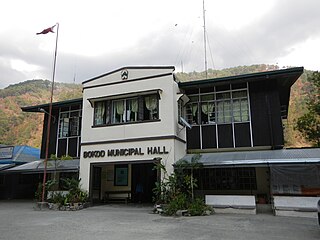
Pudtol, officially the Municipality of Pudtol,, is a 4th class municipality in the province of Apayao, Philippines. According to the 2020 census, it has a population of 15,491 people.

Santa Marcela, officially the Municipality of Santa Marcela, is a 4th class municipality in the province of Apayao, Philippines. According to the 2020 census, it has a population of 13,317 people.

Bucloc, officially the Municipality of Bucloc, is a 6th class municipality in the province of Abra, Philippines. According to the 2020 census, it has a population of 2,395 people.

Daguioman, officially the Municipality of Daguioman, is a 5th class municipality in the province of Abra, Philippines. According to the 2020 census, it had a population of 2,019 people, making it the least populated town in the province and the entire Cordillera Administrative Region.

Dolores, officially the Municipality of Dolores, is a 5th class municipality in the province of Abra, Philippines. According to the 2020 census, it has a population of 11,512 people.

La Paz, officially the Municipality of La Paz, is a 5th class municipality in the province of Abra, Philippines. According to the 2020 census, it has a population of 16,493 people.

Lacub, officially the Municipality of Lacub, is a 5th class municipality in the province of Abra, Philippines. According to the 2020 census, it has a population of 3,612 people.

Licuan-Baay, officially the Municipality of Licuan-Baay, is a 5th class municipality in the province of Abra, Philippines. According to the 2020 census, it has a population of 4,566 people.

Boliney, officially the Municipality of Boliney, is a 5th class municipality in the province of Abra, Philippines. According to the 2020 census, it has a population of 4,551 people.

Malibcong, officially the Municipality of Malibcong, is a 5th class municipality in the province of Abra, Philippines. According to the 2020 census, it has a population of 4,027 people.

Manabo, officially the Municipality of Manabo, is a 5th class municipality in the province of Abra, Philippines. According to the 2020 census, it has a population of 11,611 people.

Pidigan, officially the Municipality of Pidigan, is a 5th class municipality in the province of Abra, Philippines. According to the 2020 census, it has a population of 12,475 people.

Pilar, officially the Municipality of Pilar, is a municipality in the province of Abra in the Cordillera Administrative Region of the Philippines. The population was 10,146 at the 2020 census.

Sallapadan, officially the Municipality of Sallapadan, is a 5th class municipality in the province of Abra, Philippines. According to the 2020 census, it has a population of 6,389 people.

Tineg, officially the Municipality of Tineg, is a 2nd class municipality in the province of Abra, Philippines. According to the 2020 census, it has a population of 4,977 people.

Calanasan, officially the Municipality of Calanasan, (Isnag: Ili naya Calanasan; Ilocano: Ili ti Calanasan; Tagalog: Bayan ng Calanasan), is a 1st class municipality in the province of Apayao, Philippines. According to the 2020 census, it has a population of 12,550 people, making it the least populated municipality in the province.

Conner, officially the Municipality of Conner,, is a 2nd class municipality in the province of Apayao, Philippines. According to the 2020 census, it has a population of 27,552 people making it the most populous town in the province.

Flora, officially the Municipality of Flora, is a 3rd class municipality in the province of Apayao, Philippines. According to the 2020 census, it has a population of 17,944 people.

Kabugao, officially the Municipality of Kabugao, is a 1st class municipality and de jure capital of the province of Apayao, Philippines. According to the 2020 census, it has a population of 16,215 people.

Bokod, officially the Municipality of Bokod,, is a 4th class municipality in the province of Benguet, Philippines. According to the 2020 census, it has a population of 14,435 people.

























